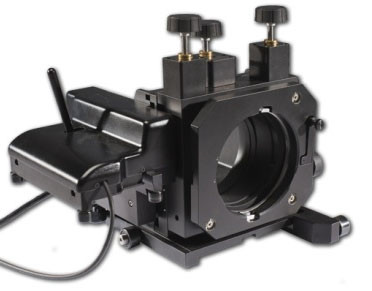曲率半径测量的意义
光学元件的曲率半径,是光学设计与制造的一个重要参数。
使用菲索式激光干涉仪,测得的球面面形结果,是去除最佳拟合球面之后的面形误差。其意义在于,被测表面有多接近一个最佳拟合的理想球面,但这个最佳球面曲率半径是多少,和器件的设计值差多少,是不知道的。
为了全面了解光学器件的性能,还需要需要精确计量球面光学器件的曲率半径。
使用激光干涉仪,测试曲率半径的原理及步骤:
激光干涉仪通过测试干涉条纹,可以精确判定“猫眼”和共焦位置;通过光栅尺或激光测距仪,可精确记录下自“猫眼”至共焦位置的位移。最终,曲率半径等于,“猫眼”至共焦位置(或者共焦至“猫眼”位置)的位移,加上干涉仪在两个位置,根据干涉条纹测得精确位置补偿。
R(曲率半径)=Z(位移读数)+Z(猫眼位置补偿)+Z(共焦位置补偿)
注:当球面标准镜产生的激光波前,正好汇聚于球面上时,会产生特殊类似“猫眼”的条纹,所以称这一位置为“猫眼”位置。
曲率半径测试的配置及精度:
在所有硬件选项中,使用光栅尺还是使用激光测距仪来记录位移变化,决定了曲率半径测量的最好精度。ZYGO提供两种可选配置,光栅尺的位移分辨率为0.1um, 而激光测距仪的分辨率可以到纳米级别。
ZYGO提供了不同长度(1.5m,2m)的导轨可选,这些导轨都可以通过标准预留的接口,与ZYGO各个型号激光干涉仪主机连接。
可以选用全自动,或手动倾斜和Z轴调整的夹具。自动位移和倾斜调整的夹具,配合ZYGO软件,可以实现曲率半径自动重复测量,多次结果平均,以提高测试结果的重复性。

空气扰动,温度变化,振动对于面形测试精度有比较大的影响,稳定的环境是高精度波前干涉测量的关键;这样才能确保“猫眼”及共焦位置的测试精度。
卧式配置的光学平台和导轨结构;立式系统的支撑及丝杆机构;都需要专门设计,具备良好的机械精度和稳定性。
测试系统需要仔细的调校和标定。
理想情况下,使用光栅尺记录位移,短腔曲率半径测试重复性可以达到微米级别;如果使用激光测距仪记录位移,采用特殊设计的架构和夹具,如下图所示,ZYGO MetroCell 或 VWS(Vertical Work Station)解决方案,曲率半径测试最高可达到PPM百万分之一,短腔百纳米级别的重复性。
需要了解更多关于ZYGO曲率半径测试的相关信息么?
赶紧和我们联系吧!
四川炬科光学前身是成都炬科光学,作为一家技术型的加工企业,为了做好光学透镜的面形和曲率半径,我们有两台ZYGO和大量的标准球面镜,目前可测试的曲率半径范围大概-1000~1000mm,有了准确的检测,让我们可以量化的检测光学透镜的曲率半径和面形。有光学透镜产品需要,何不试试四川炬科光学加工的可靠的光学透镜呢?四川炬科光学拥有完备的曲率半径检测手段,将是您采购光学透镜值得信赖的光学透镜加工厂。